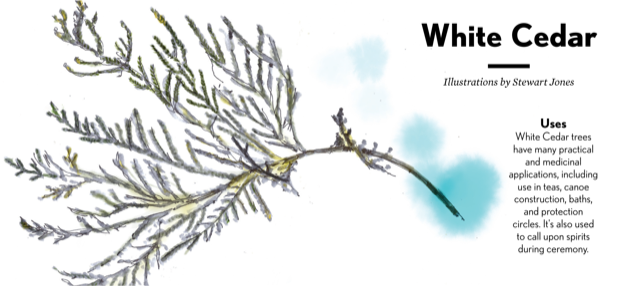(The above image is abstracted from the story of the same name from our 5th edition Discovery Guide on page 84).
“Planting white cedar is important because it represents a source of life,” says Roberta Green. “As we cleanse our bodies with cedar, it is allowing our bodies to renew themselves. Many other medicines do the exact same, but in Rites of Passage we feel that during our fasting days we become more attached to cedar than any other medicine.”
Roberta is one of several Kanien’kehá:ka (Mohawk) youth participating in the Oheró:kon (Mohawk for “Under the Husk”) Rites of Passage program, designed to pass on traditional ways, roles, responsibilities and ceremonies to assist the youth in their transition to adulthood.
Over the past four years, the program’s members have participated in cultural teachings, sweats and fasts, which require the use of white cedar. A dire shortage of trees in the Territory prompted the replanting initiative, named “Enshatinonhkwatsherayén:tho,” which means “They will plant medicines again,” in Kanien’kéha, the Mohawk language.
In replenishing this cherished community resource these mindful young leaders are respecting the past, and protecting the future.
Planting
As part of the Rites of Passage program, Mohawk youth planted 150 white cedar trees in Kenhtè:ke (Tyendinaga) public spaces. The new growth makes the medicine accessible for all community members.
Uses
White Cedar trees have many practical and medicinal applications, including use in teas, canoe construction, baths, and protection circles. It’s also used to call upon spirits during ceremony.
Be sure to check out our events calendar, follow us on Facebook, Instagram and Twitter and sign up for our newsletter for more of what happens here in the BoQ.








